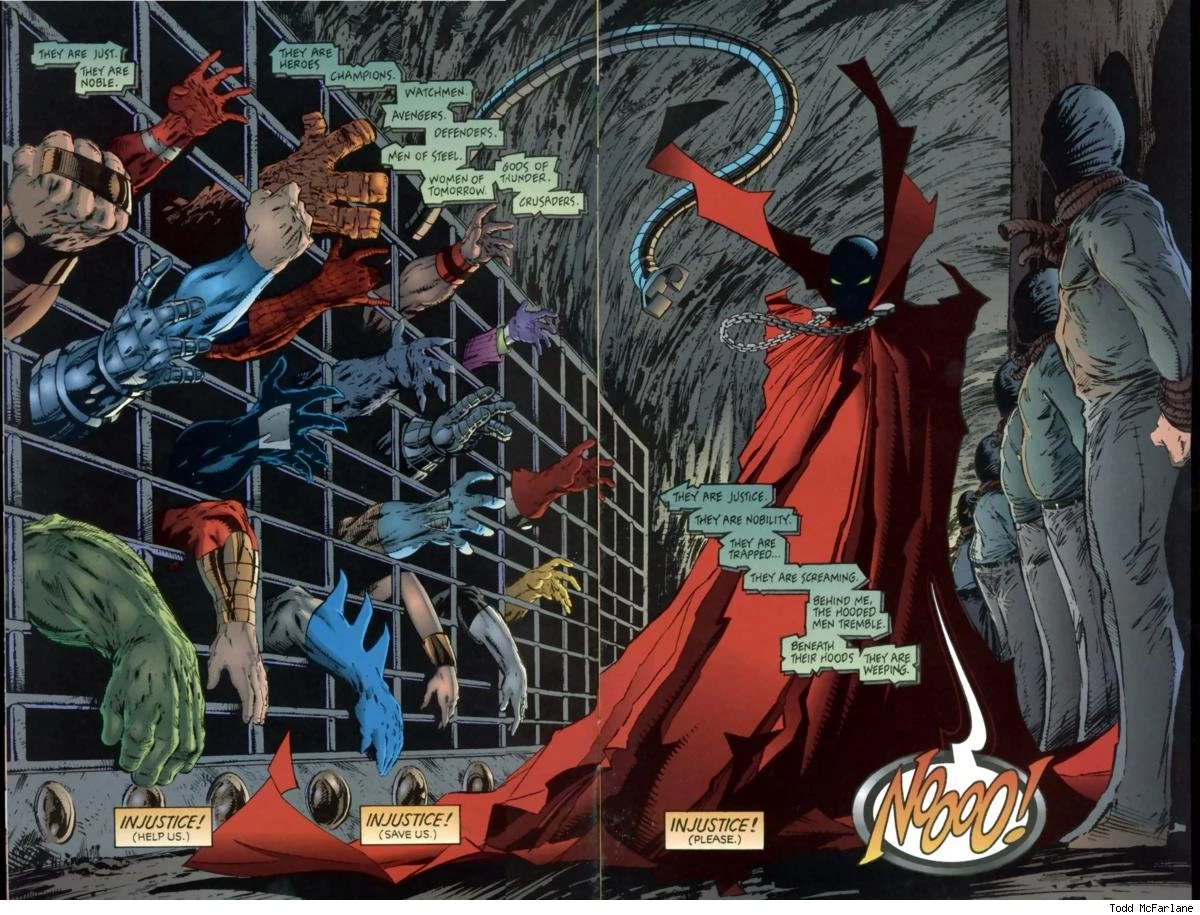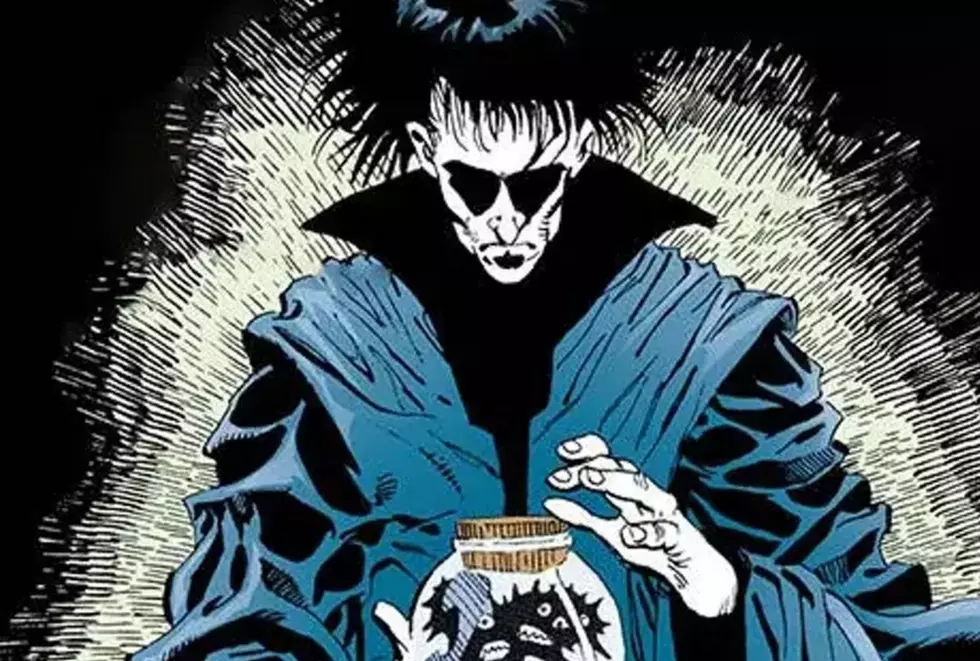
Spawn 20 Years Later: Looking Back at the Quintessential ’90s Comic Book

In stores this month is Spawn Compendium Volume 1, a gargantuan tome collecting the first fifty-ish issues, marking the 20th anniversary of Spawn's creation. At 984 pages, this collection may even be as heavy as the subject of Todd McFarlane and his most popular creation. Marty McFly heavy. It's a metaphor. When the series debuted it was an amazing success, becoming the highest-selling independent comic book of all time, but it's impossible not to see Spawn now through the lens of time. For those read the comic during its initial publication, the Spawn Compendium is a virtual time machine, whooshing us back to the joy and confusion of our teens. For entirely new readers it must be like studying artifacts. Spawn is the quintessential '90s comic, inseparable from the trends and events that lead to its creation, and its subsequent impact on the industry.In the late 1980s, Todd McFarlane quickly worked his way up the ranks at Marvel. After a high-quality but tumultuous run on The Incredible Hulk with Peter David, and a mega-popular stint on Amazing Spider-Man with David Michelinie, he convinced editorial to give him his own series. Spider-Man, written and drawn by McFarlane, sold 2.5 million copies in its debut, aided by the sudden comics collecting boom, a willing direct market that included national retailer Wal-Mart, and Gold, Silver, and Platinum variant covers. With the money rolling in for his comics at Marvel, McFarlane began to wonder why he didn't get a bigger piece of the pie.
Conversations with other highly popular artists like Jim Lee and Rob Liefeld lead to the realization that they were in the same boat: drawing comicbooks that were regularly selling in the upper six figures, but without any claim to a share of the rewards. When they organized and demanded more, Marvel said that it didn't matter who the artist was, it was the property that got big sales. Rightfully so, McFarlane and the others took offense, and elected to leave Marvel and form their own company. In all, there were seven creators -- Todd McFarlane, Jim Lee, Rob Liefeld, Marc Silvestri, Erik Larsen, Jim Valentino, and Whilce Portacio -- and the result was Image Comics.
 The anticipation cultivated by the grand announcements and sheer gall of the move practically guaranteed Image's early success. It was the biggest story in the comics community at every level. It was what the pros discussed, it was all the expanding journalistic level could write about, and it was all the fans could talk about. Everybody and their comics-collecting uncle knew they would be buying first issues of Spawn, WildCATS, and Youngblood long before they actually got a look at them. It was inevitable. Just how popular was still in question.
The anticipation cultivated by the grand announcements and sheer gall of the move practically guaranteed Image's early success. It was the biggest story in the comics community at every level. It was what the pros discussed, it was all the expanding journalistic level could write about, and it was all the fans could talk about. Everybody and their comics-collecting uncle knew they would be buying first issues of Spawn, WildCATS, and Youngblood long before they actually got a look at them. It was inevitable. Just how popular was still in question.
Spawn #1 sold over one million copies. 1.7 million, actually. That's how popular. Though several thousand of those copies were certainly unread collectibles, doubles, bagged-and-boarded and furrowed away forever, there were still around one million people reading Spawn, an independent comicbook featuring a creator-owned character. Wheels were set in motion for toys, animated series, and movies in short order. Everyone was reading it -- the metal kids, the jocks, the cool teachers, and several others who didn't normally read comics. The TMNT phenomenon had returned, dunked in blood and guts and adorned in chains.
The first issue of Spawn showed a darker side McFarlane had only hinted at in Spider-Man. Spawn was a resurrected agent of Hell sent wandering and brooding through the violent streets -- and lightning-kissed Gothic cathedrals -- of New York City. It was the grim and gritty movement amplified through an overdriven Marshall and blasted across splash pages.
McFarlane had great influences that he wasn't afraid to wear them on his sleeve, and the first nine pages of Spawn #1 practically list them off. After a seriously decompressed opening heavy on the Frank Miller, there's a single page of an Alan Moore nine-panel grid, then a few pages paying tribute to Jack Kirby, Steve Ditko, and Jim Steranko. Spawn's introduction to the world ends with a splash page into a two-page spread. And there's even a "removable" poster stapled into the center of the issue. 'Twas only the beginning of the full-page heroic pose phenomenon, though. 'Twas.
At the time, McFarlane's visuals were state-of-the-art: striking, dynamic, and fast-paced, but still fluid and cartoony. Subtlety had no place in McFarlane's looping, nasty layouts. On Spawn, he shed all the formal conventions of figure and perspective and just went for it. The results were mixed. Constant full-page poses -- which sold for much higher on the original art market -- threw off the story's rhythm. Some pages, even full issues, look last-minute and dashed off. But as the series went on, there was a definite progression to his approach, and several issues justify his status as a superstar artist. There was just something about his pages that made you want to look at them.
As a writer, McFarlane had a decent skillset; he had an artist's sense of pacing, knew how to strike a mood, and even in that first issue we saw some snappy dialogue, especially with Sam and Twitch, the detectives on Spawn's trail. But his plotting skills left a lot to be desired, and Spawn's internal monologue comes off like a weak imitation of Miller that for some reason breaks into second-person for no reason at all. Perhaps that was a deciding element in his decision to draft several high-profile guest writers for a run that may be one of the most significant nexus points in recent comic history.

Alan Moore, Neil Gaiman, Dave Sim, and Frank Miller four of the most-celebrated writers of the 1980s and early 1990s, took over Spawn from issues 8 to 11. Each contribution is significant and controversial in its own way. Moore was first, with "In Heaven", a basic Alan Moore Swamp Thing-like tale of child molester Billy Kincaid's trip through the Spheres of Hell. Not ground-breaking, but it served as Moore's re-entry into superhero comics, which he had sworn off a few years before in favor of works like From Hell and Big Numbers. From here, Moore went on to work on Jim Lee's WildC.A.T.S., Rob Liefeld's Youngblood, Glory, and Supreme. Supreme was easily his best work in Liefeld's "Awesome Universe," an analogous take on Superman with masterful art by Rick Veitch that revived the thrill of invention of the Silver Age.
The next issue, written by Neil Gaiman, is the source of a long-running legal dispute between Gaiman and McFarlane, which concluded this week. The dispute centers around the ownership of the characters Angela, Medieval Spawn, and Cogliostro. Though Gaiman has always maintained they were created by him specifically for that one-issue story, McFarlane added them to Spawn lore when Gaiman wasn't looking. These were recurring characters, and ones that got their own toys, and appearances in the animated series and 1997 film. McFarlane's image as a champion of creator's rights was seriously tarnished, which was particularly ironic considering the subject of the next issue.
Dave Sim can be called many, many things, almost all of them true. In 1993, the word most-often used to describe the writer/artist was "genius." (Or Genius. Inside joke.) His then-fifteen-year-long, self-published Cerebus was the independent comic book of the era: beautiful, intelligent, experimental, and at a higher readership than ever before. Spawn readers had no idea. Sim's contribution to the Spawn legacy is easily the most compelling of the lot, delivering a story that is both dreamy and articulate. "Crossing Over" is an emotional/metaphysical plea for creator's rights that breaks the plane between fiction and reality.
After some of McFarlane's best work on the series in the depiction of Creator's Hell, Sim appears as Cerebus to extol the virtues of self-publishing to Spawn/McFarlane. There was a big response for the story, and somewhat prophetically of the title, many readers did in fact cross over to begin reading independent comics. Cerebus's readership jumped, and at just the perfect time: about a year before the infamous issue #186, which cemented Sim's reputation as a misogynist and cut his fanbase in half. Essentially, it gave Sim a bigger audience for his meltdown.

The last of the guest-written stories is issue 11, by Frank Miller, a collaboration that led to the Spawn/Batman crossover written by Miller and drawn by McFarlane. Even in retrospect, it exceeds expectations, and reads like a war poem performed by a coked-up caveman. While working on the project, McFarlane handed the reins over to Grant Morrison and Greg Capullo for three issues. In doing so, he became an administrator, and began his journey to entrepeneur.
He never needed to work another day in his life. Certainly not in comic books, anyway. The Spawn property had eclipsed comics; there was the movie to think about, McFarlane Toys to consider. He took the Stan Lee route. He drew a few more issues, then went on as writer and inker to Capullo's pencils for a couple years, then left the series completely. He did contribute to the 200th issue "bi-Spawntennial," but not much, and it did not receive good reviews.
Time creeps up on you. Perception shifts and tastes change, and things that once got your heart beating make you hate yourself now, but Spawn is still important. It drew new readers in, and then sent them outward. Those four issues especially provided an entry point into better comics for many readers, myself included. It inspired the wave that ruined superhero comics, and the resultant backlash in the late 1990s that has resulted in better storytelling even today.
Spawn got people to read comics. And then encouraged them to read better comics than Spawn.
More From ComicsAlliance








![Bill Sienkiewicz Provides FOC Variant Cover For ‘American Gods: Shadows’ #2 [Exclusive]](http://townsquare.media/site/622/files/2017/03/AMGODS0.png?w=980&q=75)
